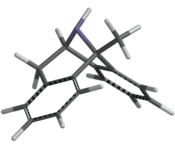 | |
 | |
| Clinical data | |
|---|---|
| Routes of administration | By mouth, IM |
| Identifiers | |
| |
| CAS Number | |
| PubChem CID | |
| IUPHAR/BPS | |
| DrugBank | |
| ChemSpider | |
| UNII | |
| ChEBI | |
| ChEMBL | |
| CompTox Dashboard (EPA) | |
| Chemical and physical data | |
| Formula | C16H15N |
| Molar mass | 221.303 g·mol−1 |
| 3D model (JSmol) | |
| Melting point | 68.75 °C (155.75 °F) |
| |
| |
| | |
Dizocilpine (INN), also known as MK-801, is a pore blocker of the NMDA receptor, a glutamate receptor, discovered by a team at Merck in 1982.[1] Glutamate is the brain's primary excitatory neurotransmitter. The channel is normally blocked with a magnesium ion and requires depolarization of the neuron to remove the magnesium and allow the glutamate to open the channel, causing an influx of calcium, which then leads to subsequent depolarization.[2] Dizocilpine binds inside the ion channel of the receptor at several of PCP's binding sites thus preventing the flow of ions, including calcium (Ca2+), through the channel. Dizocilpine blocks NMDA receptors in a use- and voltage-dependent manner, since the channel must open for the drug to bind inside it.[3] The drug acts as a potent anti-convulsant and probably has dissociative anesthetic properties, but it is not used clinically for this purpose because of the discovery of brain lesions, called Olney's lesions (see below), in laboratory rats. Dizocilpine is also associated with a number of negative side effects, including cognitive disruption and psychotic-spectrum reactions. It inhibits the induction of long term potentiation[4] and has been found to impair the acquisition of difficult, but not easy, learning tasks in rats[5][6] and primates.[7] Because of these effects of dizocilpine, the NMDA receptor pore blocker ketamine is used instead as a dissociative anesthetic in human medical procedures. While ketamine may also trigger temporary psychosis in certain individuals, its short half-life and lower potency make it a much safer clinical option. However, dizocilpine is the most frequently used uncompetitive NMDA receptor antagonist in animal models to mimic psychosis for experimental purposes.
Dizocilpine has also been found to act as a nicotinic acetylcholine receptor antagonist.[8][9][10] It has been shown to bind to and inhibit the serotonin and dopamine transporters as well.[11][12]
- ^ US Patent 4399141, Anderson P, Christy ME, Evans BE, "5-Alkyl or hydroxyalkyl substituted-10,11-imines & Anticonvulsant Use Thereof", issued 1983-08-16, assigned to Merck & Company Inc
- ^ Foster AC, Fagg GE (1987). "Neurobiology. Taking apart NMDA receptors". Nature. 329 (6138): 395–396. doi:10.1038/329395a0. PMID 2443852. S2CID 5486568.
- ^ Huettner JE, Bean BP (February 1988). "Block of N-methyl-D-aspartate-activated current by the anticonvulsant MK-801: selective binding to open channels". Proceedings of the National Academy of Sciences of the United States of America. 85 (4): 1307–1311. doi:10.1073/pnas.85.4.1307. PMC 279756. PMID 2448800.
- ^ Coan EJ, Saywood W, Collingridge GL (September 1987). "MK-801 blocks NMDA receptor-mediated synaptic transmission and long term potentiation in rat hippocampal slices". Neuroscience Letters. 80 (1): 111–114. doi:10.1016/0304-3940(87)90505-2. PMID 2821457. S2CID 268615.
- ^ Murray TK, Ridley RM, Snape MF, Cross AJ (August 1995). "The effect of dizocilpine (MK-801) on spatial and visual discrimination tasks in the rat". Behavioural Pharmacology. 6 (5 And 6): 540–549. doi:10.1097/00008877-199508000-00014. PMID 11224361. S2CID 29029744.
- ^ Murray TK, Ridley RM (October 1997). "The effect of dizocilpine (MK-801) on conditional discrimination learning in the rat". Behavioural Pharmacology. 8 (5): 383–388. doi:10.1097/00008877-199710000-00002. PMID 9832977. S2CID 27485569.
- ^ Harder JA, Aboobaker AA, Hodgetts TC, Ridley RM (November 1998). "Learning impairments induced by glutamate blockade using dizocilpine (MK-801) in monkeys". British Journal of Pharmacology. 125 (5): 1013–1018. doi:10.1038/sj.bjp.0702178. PMC 1565679. PMID 9846639.
- ^ Ramoa AS, Alkondon M, Aracava Y, et al. (July 1990). "The anticonvulsant MK-801 interacts with peripheral and central nicotinic acetylcholine receptor ion channels". The Journal of Pharmacology and Experimental Therapeutics. 254 (1): 71–82. PMID 1694895.
- ^ Amador M, Dani JA (March 1991). "MK-801 inhibition of nicotinic acetylcholine receptor channels". Synapse. 7 (3): 207–15. doi:10.1002/syn.890070305. PMID 1715611. S2CID 45243975.
- ^ Briggs CA, McKenna DG (April 1996). "Effect of MK-801 at the human alpha 7 nicotinic acetylcholine receptor". Neuropharmacology. 35 (4): 407–14. doi:10.1016/0028-3908(96)00006-8. PMID 8793902. S2CID 54377970.
- ^ Iravani MM, Muscat R, Kruk ZL (June 1999). "MK-801 interaction with the 5-HT transporter: a real-time study in brain slices using fast cyclic voltammetry". Synapse. 32 (3): 212–24. doi:10.1002/(SICI)1098-2396(19990601)32:3<212::AID-SYN7>3.0.CO;2-M. PMID 10340631. S2CID 1419196.
- ^ Clarke PB, Reuben M (January 1995). "Inhibition by dizocilpine (MK-801) of striatal dopamine release induced by MPTP and MPP+: possible action at the dopamine transporter". British Journal of Pharmacology. 114 (2): 315–22. doi:10.1111/j.1476-5381.1995.tb13229.x. PMC 1510234. PMID 7881731.